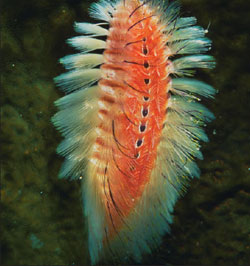Segmented Worms
 |
| Chloeia sp., a polychaete. |
The evolutionary advent of metamerism was highly significant because it made possible development of much greater complexity in structure and function. Metamerism not only increased efficiency of burrowing but also made possible independent and separate movements by separate segments. A need for fine control of movements led, in turn, to evolution of a more sophisticated nervous system. Moreover, repetition of body parts gave the organisms a built-in redundancy, as in some human-made systems. Redundancy provided a safety factor: if one segment should fail, others could still function. Thus an injury to one part would not necessarily be fatal.
The evolutionary potential of the metameric body plan is amply demonstrated by the large and diverse phylum Arthropoda. Metamerism also arose independently in the deuterostome line, which includes the numerous and adaptively diverse vertebrates.
Phylum Annelida (an-nel´i-da) (L. annelus, little ring, + ida, pl. suffix) consists of the segmented worms. It is a large phylum, numbering approximately 15,000 species, the most familiar of which are earthworms and freshwater worms (oligochaetes) and leeches (hirudineans). However, approximately two-thirds of the phylum is composed of marine worms (polychaetes), which are less familiar to most people. Among the latter are many curious members; some are strange, even grotesque, whereas others are graceful and beautiful. They include clamworms, plumed worms, parchment worms, scaleworms, lugworms, and many others. Annelids are true coelomates and belong to the protostome branch, with spiral cleavage and mosaic development. They are a highly developed group in which the nervous system is more centralized and the circulatory system more complex than those of phyla we have studied thus far.
Annelida are worms whose bodies are divided into similar rings, or segments, arranged in linear series and externally marked by circular grooves called annuli; the name of the phylum refers to this characteristic. Body segmentation, or metamerism, in annelids is not merely an external feature but is also seen internally in the repetitive arrangement of organs and systems and in the delimiting of segments (also called metameres or somites) by septa. Metamerism is not limited to annelids; it is shared by arthropods (insects, crustaceans, and others), whose metamerism may be homologous to that in annelids, and also by vertebrates, in which it evolved independently.
Annelids are sometimes called “bristle worms” because, with the exception of leeches, most annelids bear tiny chitinous bristles called setae (L. seta, hair or bristle). Short needlelike setae help anchor the somites during locomotion to prevent backward slipping; long, hairlike setae aid aquatic forms in swimming. Since many annelids either are burrowers or live in secreted tubes, stiff setae also aid in preventing the worm from being pulled out or washed out of its home. Robins know from experience how effective earthworms’ setae are.
Annelids have a worldwide distribution, and a few species are cosmopolitan. Polychaetes are chiefly marine forms. Most are benthic, but some live pelagic in the sea. Oligochaetes and leeches occur predominantly in fresh water or terrestrial soils. Some freshwater species burrow in mud and sand and others among submerged vegetation. Many leeches are predators, and many are specialized for piercing their prey and feeding on blood or soft tissues. A few leeches are marine, but most of them live in fresh water or in damp regions. Suckers are typically found at both ends of the body for attachment to the substratum or to their prey.
Position in Animal Kingdom
- Annelids belong to the protostome branch of the animal kingdom and have spiral cleavage and mosaic (determinate) development, characters in common with and that indicate relationship with molluscs and simple arthropods.
- Annelids as a group show a primitive metamerism with comparatively few differences between the different somites.
- Characters shared with arthropods include an outer secreted cuticle and a similar nervous system.
Biological Contributions
- The introduction of metamerism by the group represents the greatest innovation seen in this phylum. A more highly specialized metamerism is seen in arthropods.
- A true coelomic cavity reaches a high stage of development in this group.
- Specialization of the head region into differentiated organs, such as tentacles, palps, and eyespots of polychaetes, is carried further in some annelids than in other invertebrates so far considered.
- There are modifications of the nervous system, with cerebral ganglia (brain), two closely fused ventral nerve cords with giant fibers running the length of the body, and various ganglia with their lateral branches.
- The circulatory system is much more complex than any we have so far considered. It is a closed system with muscular blood vessels and aortic arches (“hearts”) for propelling the blood.
- The appearance of the fleshy parapodia, with their respiratory and locomotor functions, introduces a suggestion of the paired appendages and specialized gills found in arthropods.
- Well-developed nephridia in most of the somites have reached a differentiation that involves removal of waste from the blood as well as from the coelom.
- Annelids are the most highly organized animals capable of complete regeneration. However, this ability varies greatly within the group.




